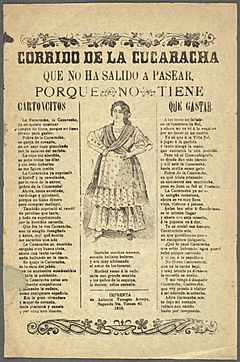La Cucaracha facts for kids
La Cucaracha ("The Cockroach") is a very old and famous Spanish folk song. No one knows exactly when it was first sung. It is also super popular in many countries in Latin America. In Mexico, people sang it a lot during the Mexican Revolution. There are many different versions of the song. The main idea of the song is about a cockroach that has trouble walking.
What the Song is About
The earliest words of "La Cucaracha" tell the story of a cockroach. This cockroach has lost one of its six legs. It struggles to walk with only five legs. The way the song sounds tries to copy the cockroach's uneven walk.
The original chorus of the song goes like this:
- La cu-ca- | ra-cha, la cu-ca-ra-cha
- | ya no pue-de ca-mi-nar
- por-que no | tie-ne, por-que le fal-tan
- | las dos pa- titas "de" a-trás.
This means: "The cockroach, the cockroach / can no longer walk / because she doesn't have, because she lacks / the two hind legs to walk." These words are the base for most versions of the song you hear today.
How the Song is Built
The song is made of parts that repeat. It has a verse part and a chorus part. Each of these parts has four lines. The second and fourth lines of each part rhyme with each other. This is called an ABCB rhyme pattern.
Many newer versions of the song have changed the words. They might not talk about the cockroach's missing legs anymore. The rhythm of the song has also changed over time. Most modern versions have a beat that makes it feel like three pulses.
"La Cucaracha" in History
"La Cucaracha" became very popular in Mexico during the Mexican Revolution. This was a big war that happened in Mexico from 1910 to 1920. Soldiers and people fighting in the revolution often changed the song's words. They would make up new verses to talk about their leaders, battles, or political ideas.
Because of this, there are hundreds of different versions of "La Cucaracha." Each version might have unique lyrics that tell a different story or share a different message. This makes the song a special part of Mexican history and culture. It shows how music can be used to share news and feelings during important times.
See also
 In Spanish: La cucaracha para niños
In Spanish: La cucaracha para niños


